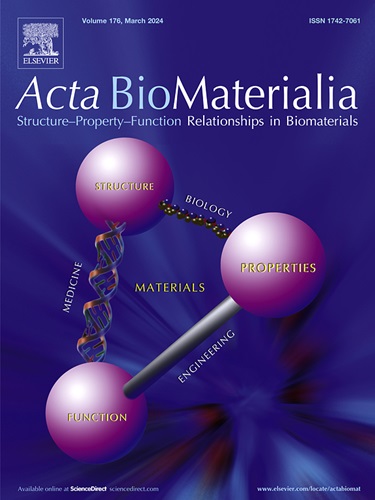Additively manufactured biodegradable Zn-Mn-based implants with an unprecedented balance of strength and ductility
IF 9.4
1区 医学
Q1 ENGINEERING, BIOMEDICAL
引用次数: 0
Abstract
Additively manufactured (AM) biodegradable zinc alloys hold huge potential as promising candidates for bone defect and fracture repair, thanks to their suitable biodegradation rates and acceptable biocompatibility. However, the mechanical properties of AM zinc alloys developed so far, ductility in particular, fall short of the requirements for bone substitution. Here, we present Zn-1Mn and Zn-1Mn-0.4Mg alloy implants with unique microstructures, fabricated using laser powder bed fusion (LPBF). Notably, the LPBF Zn-Mn-Mg alloy exhibited an extraordinary balance of strength and ductility, with an ultimate tensile strength of 289 MPa, yield strength of 213.5 MPa, and elongation over 20 %, outperforming all previously reported AM zinc alloys. The simultaneously enhanced strength and ductility of the ternary alloy were attributed to the strong grain-refining effect of the Mg2Zn11 second phase and the synthetic strengthening caused by the dispersion of the MnZn13 and Mg2Zn11 second phases inside the grains and at the grain boundaries. In addition, both alloys had similar rates of in vitro biodegradation (∼0.15 mm/year), properly aligned with the bone remodeling process, while also demonstrating favorable biocompatibility and upregulating multiple osteogenic markers. The Zn-Mn-Mg alloy showed even better osteogenic potential than the Zn-Mn alloy, owing to the addition of Mg. The combined attributes of the LPBF Zn-Mn-Mg ternary alloy indicated huge potential for its use as a bone repair material, especially for load-bearing bone fixation.
Statement of significance
The mechanical properties of previously developed additively manufactured biodegradable zinc alloys, especially ductility, have not met the requirements for bone repair. Using laser powder bed fusion (LPBF), we fabricated Zn-1Mn and Zn-1Mn-0.4Mg alloy implants with unique microstructures. The LPBF Zn-Mn-Mg alloy demonstrated an exceptional balance of strength and ductility, achieving a tensile strength of 289 MPa, yield strength of 213.5 MPa, and elongation over 20 %, surpassing all reported AM zinc alloys. This study is the first to produce a directly printed biodegradable alloy meeting the mechanical requirements for bone fixation devices without post-processing. Additionally, the alloy exhibited moderate a biodegradation rate and excellent biocompatibility, underscoring its potential for load-bearing bone repair applications.

增材制造的可生物降解的锌锰基植入物具有前所未有的强度和延展性平衡。
增材制造(AM)可生物降解锌合金由于其合适的生物降解率和可接受的生物相容性,在骨缺损和骨折修复方面具有巨大的潜力。然而,目前开发的增材制造锌合金的力学性能,特别是延展性,还不能满足骨替代的要求。本文采用激光粉末床熔合(LPBF)技术制备了具有独特显微结构的Zn-1Mn和Zn-1Mn-0.4 mg合金植入物。值得注意的是,LPBF Zn-Mn-Mg合金在强度和延展性方面表现出了非凡的平衡,其极限抗拉强度为289 MPa,屈服强度为213.5 MPa,伸长率超过20%,优于之前报道的所有AM锌合金。合金的强度和塑性同时增强主要是由于Mg2Zn11第二相的强细化作用以及MnZn13和Mg2Zn11第二相在晶粒内和晶界处的弥散引起的综合强化。此外,两种合金具有相似的体外生物降解率(~ 0.15 mm/年),适当地与骨重塑过程对齐,同时也显示出良好的生物相容性和上调多种成骨标志物。由于Mg的加入,Zn-Mn-Mg合金表现出比Zn-Mn合金更好的成骨潜能。LPBF Zn-Mn-Mg三元合金的综合性能表明其作为骨修复材料,特别是在承重骨固定方面具有巨大的应用潜力。意义声明:先前开发的添加剂制造的可生物降解锌合金的机械性能,特别是延展性,还没有达到骨修复的要求。采用激光粉末床熔合(LPBF)制备了具有独特显微组织的Zn-1Mn和Zn-1Mn-0.4 mg合金植入物。LPBF Zn-Mn-Mg合金在强度和延展性方面表现出优异的平衡,抗拉强度达到289 MPa,屈服强度达到213.5 MPa,伸长率超过20%,超过所有报道的AM锌合金。本研究首次生产出直接打印的生物可降解合金,满足骨固定装置的机械要求,无需后处理。此外,该合金表现出适度的生物降解率和良好的生物相容性,强调了其在承重骨修复应用中的潜力。
本文章由计算机程序翻译,如有差异,请以英文原文为准。
求助全文
约1分钟内获得全文
求助全文
来源期刊

Acta Biomaterialia
工程技术-材料科学:生物材料
CiteScore
16.80
自引率
3.10%
发文量
776
审稿时长
30 days
期刊介绍:
Acta Biomaterialia is a monthly peer-reviewed scientific journal published by Elsevier. The journal was established in January 2005. The editor-in-chief is W.R. Wagner (University of Pittsburgh). The journal covers research in biomaterials science, including the interrelationship of biomaterial structure and function from macroscale to nanoscale. Topical coverage includes biomedical and biocompatible materials.
 求助内容:
求助内容: 应助结果提醒方式:
应助结果提醒方式:


